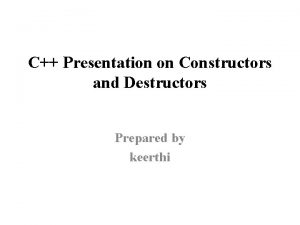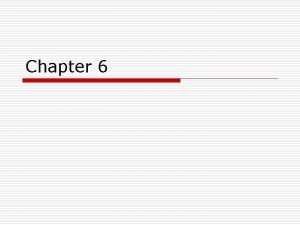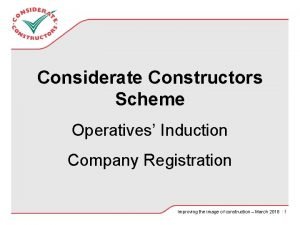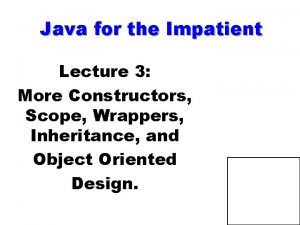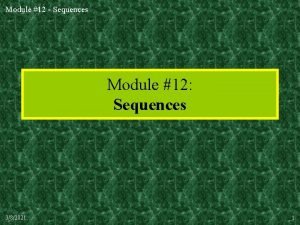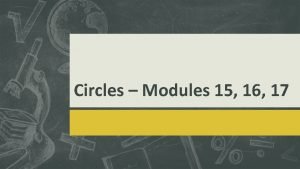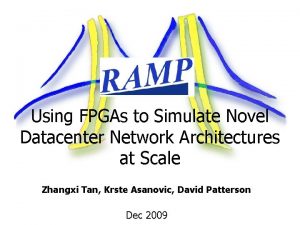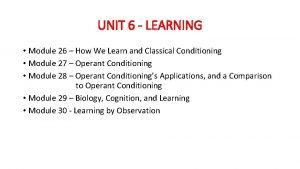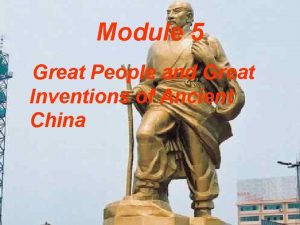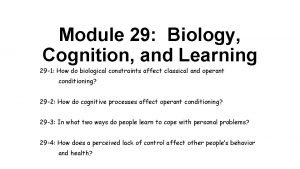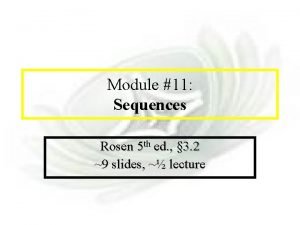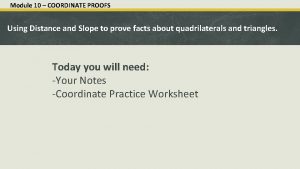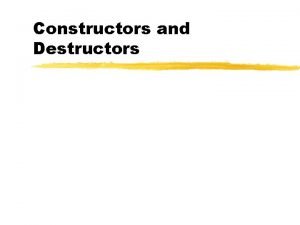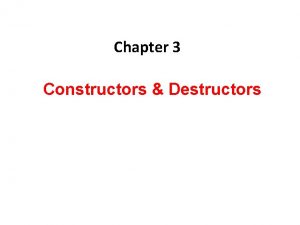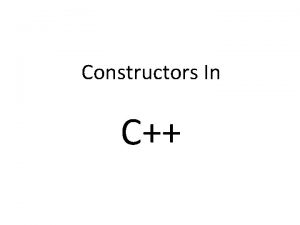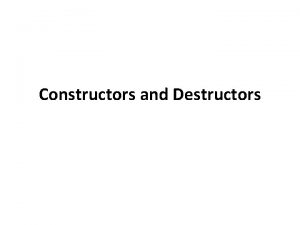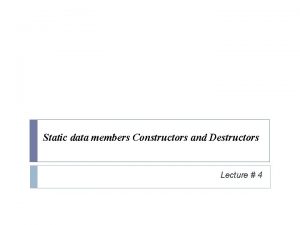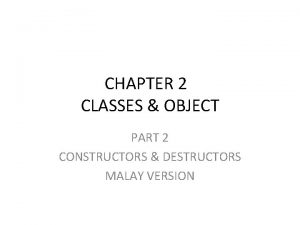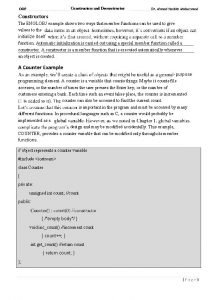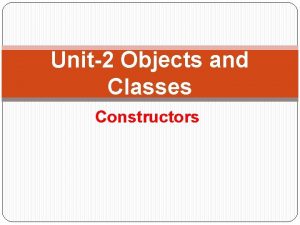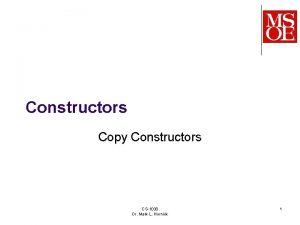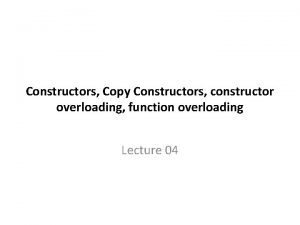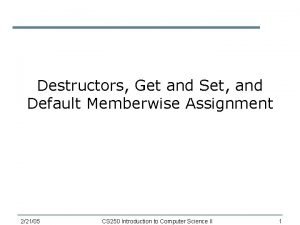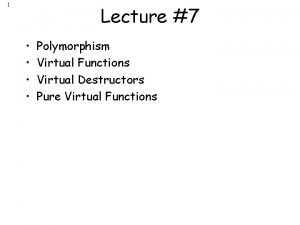Module 7 Constructors and Destructors In this module
































- Slides: 32

Module 7: Constructors and Destructors: In this module we will cover: • Constructors Default constructor Other constructors Copy constructor • Quirks about constructors • Destructor Scientific Computing in OO Module 7: Constructors #1 Course code 3 C 59 2000/2001

Aims of this module We have previously introduced the concept of a “class” as a construct which combines member variables and methods in a formal way. In this module you will learn about a new and vitally important part of a class which determines how an object gets made. This all revolves around the idea of "Constructors" which are special methods which get called automatically to initialise objects. Associated with these are "Destructors" which get called when an object goes out of scope or is deleted. These are fundamental new concepts in OO and you must use these from early on. Therefore this module covers their use in some detail. Scientific Computing in OO Module 7: Constructors #2 Course code 3 C 59 2000/2001

7. 1 Constructors Throughout the course so far we have seen the idea that as soon as you make an Object then you should remember to initialise is so that its member variables are set to something sensible. I. e // Make a Three. Vector and initialise the px, py, pz Three. Vector vec ; vec. initialise( 0. 8, 0. 4, 1. 3 ) If you DO NOT do something like this then you may find that your internal variables are full of some random garbage like -111111345678, or whatever happened to be left in the memory from a previous use. Scientific Computing in OO Module 7: Constructors #3 Course code 3 C 59 2000/2001

We can say the same thing in a more abstract way: When you make an object it is unlikely to be of any use unless you give it "state" which distinguishes it from other objects: Employee class umer=12345 n t u o c c a , s", age=20 g g o l b e o J " "Ann Banks", age=25, acco utnumer= "Art Scientific Computing in OO 045687 Daum ann ", a ge=5 0, ac cout nume r=89 6543 Module 7: Constructors #4 Course code 3 C 59 2000/2001

So far we have always done this by invoking this special “initialise” method explicitly after making the object. C++ formalises this by defining a “special method” which is invoked automatically for you when you make the object. This is called a Constructor To start we will see a so called: Default Constructor This doesnt actually do anything useful in the way of giving state, but shows the syntax. Then we look at more useful ones which take arguments Scientific Computing in OO Module 7: Constructors #5 Course code 3 C 59 2000/2001

The Default Constructor (no arguments) To provide a default constructor you declare it (in the. h file) as a you would any normal method. class Three. Vector { private: . . In this case the method name is the same as the class name itself public: //Normal methods float magnitude( ) ; . . // Constructor Three. Vector( ) ; The default constructor has no arguments. There is NEVER a return type }; Scientific Computing in OO Module 7: Constructors #6 Course code 3 C 59 2000/2001

. . You write the code for the method as you would for a normal method, except that there is no return type. This is of course normally sitting in a. cpp file Scientific Computing in OO // Magnitude method float Three. Vector: : magnitude( ) {. . . . } // Default constructor Three. Vector: : Three. Vector( ) { px = 0 ; py = 0 ; pz = 0 ; } Module 7: Constructors #7 Course code 3 C 59 2000/2001

Now, whenever you make a Three. Vector, this default constructor will automatically be called for you // make a Three. Vector vec ; vec. Three. Vector( ) ; . . rest of code to use vec. . . You might want to think of it as some sort of hidden call like this inserted immediately after making vec Scientific Computing in OO Module 7: Constructors #8 Course code 3 C 59 2000/2001

Other Constructors (ones which take some usefel arguments) Here is an extra constructor which takes three floating point arguments. class Three. Vector { private: . . public: //Normal methods float magnitude( ) ; . . // Constructors Three. Vector( ) ; Three. Vector( float x, float y, float z ) ; We would use this to initialise to a specific (x, y, z) rather than just (0, 0, 0). }; Scientific Computing in OO Module 7: Constructors #9 Course code 3 C 59 2000/2001

Here is the extra code in the. cpp file for the constructor taking three floats. . // Default constructor Three. Vector: : Three. Vector( ) { px = 0 ; py = 0 ; pz = 0 ; } // Extra constructor Three. Vector: : Three. Vector( float x, float y, float z ) { px = x ; py = y ; pz = z ; } Scientific Computing in OO Module 7: Constructors #10 Course code 3 C 59 2000/2001

Suppose you want to make a Three. Vector and initialise it to ( 0. 8, 0. 4, 1. 2 ). To cause the appropriate constructor to be invoked when you make the Three. Vector you simply do this: // make a Three. Vector vec( 0. 8, 0. 4, 1. 2 ) ; . . rest of code to use vec. . . Note the format: you are not supplying arguments to a method called vec is the variable name ! you are putting arguments after the variable name at the point it is created Scientific Computing in OO Module 7: Constructors #11 Course code 3 C 59 2000/2001

This is the ONLY way you can make a specific constructor get invoked: // make a Three. Vector vec( 0. 8, 0. 4, 1. 2 ) ; . . rest of code to use vec. . . You can NEVER call it yourself later like this: // make a Three. Vector vec ; . . . some code. . . vec. Three. Vector( 0. 8, 0. 4, 1. 2 ) ; This is not allowed. A thing gets constructed ONLY when it is made, not later on Scientific Computing in OO Module 7: Constructors #12 Course code 3 C 59 2000/2001

Student exercise • Write an Animal class which has member variables to represent: -The food type (carnivore, omnivore, herbivore) - the number of legs • Supply the class with (at least) two constructors: 1. One which takes the only the food type This should assume the animal has 4 legs 2. Another which takes the food type, but also the number of legs in case it is not 4. You might like to make this check that the value supplied is even and print an error message if not. • Write some code to demonstrate the use of these constructors. Hint: I would provide a dump() method for the Animal class which can be used to print out the member variable information after you have constructed a few animals Scientific Computing in OO Module 7: Constructors #13 Course code 3 C 59 2000/2001

7. 2 The copy constructor There is a special constructor which is very often provided for a class. It is called the "copy constructor" Its purpose is to constuct a new object by making an exact copy of an existing object. This example shows how it is invoked: // Example of using the copy // constructor // make a Thing t 1 ; //. . . set t 1 to something. . // make a second Thing which is // a copy of t 1 by invoking the // copy constructor Thing t 2( t 1 ) ; Scientific Computing in OO Module 7: Constructors #14 Course code 3 C 59 2000/2001

This is how you (could) declare a copy constructor class Three. Vector { private: . . public: //Normal methods float magnitude( ) ; . . // Default Constructor Three. Vector( ) ; // Copy constructor Three. Vector( Three. Vector source) ; The copy constructor takes another Three. Vector as its argument Scientific Computing in OO }; Module 7: Constructors #15 Course code 3 C 59 2000/2001

This is how you write the code for the copy constructor // This is in the. cpp file The member variables of the new object are set to equal the member variables of the source object // Copy constructor Three. Vector: : Three. Vector( Three. Vector src ) { px = src. px ; py = src. py ; pz = src. pz ; } Note how they are accessed from the source, using src. px Scientific Computing in OO Module 7: Constructors #16 Course code 3 C 59 2000/2001

If you find this difficult, you might like to realise that you have already done something very like this ! You did it when writing the dot. Product( ) method for the Three. Vector class. This method took another Three. Vector as an argument Look at this and see the similarity if you need to. Scientific Computing in OO Module 7: Constructors #17 Course code 3 C 59 2000/2001

Now you need to know about references ! go to special module on technical topics to find out what a reference is. Scientific Computing in OO Module 7: Constructors #18 Course code 3 C 59 2000/2001

In practice copy constructors are always written using a const reference to the source. This is because there is no need to waste the time and memory making a temporary copy. Thus a copy constructor is always declared thus: And written thus: Note that the code itself is unchanged Scientific Computing in OO // This is the. h file class Three. Vector { private: . . public: //Normal methods. . . // Copy constructor Three. Vector( const Three. Vector& source); }; // This is the. cpp file // Copy constructor Three. Vector: : Three. Vector( const Three. Vector& src ) { px = src. px ; py = src. py ; pz = src. pz ; } Module 7: Constructors #19 Course code 3 C 59 2000/2001

7. 3: Quirks about Constructors IMPLICIT & EXPLICIT DEFAULT CONSTRUCTORS If you ever want to make an object in the simplest way, i. e like this. . // make a Thing t ; . . . then you have to realise that the compiler will only let you do this if there exists a default constructor: Thing( ) i. e a constructor with no arguments which the system can call. Thus you have to be aware of when a default constructor exists or not ! Scientific Computing in OO Module 7: Constructors #20 Course code 3 C 59 2000/2001

1. If you NEVER explicitly declare or write ANY constructors i. e your. h file looks like this. . class Thing { // Normal variables float xxx ; // Normal methods . . . then the compiler in effect provides an implicit default constructor free. You never see it, but it is as if void a. Service(. . ) ; // But no constructors }; Thing( ) ; exists. Scientific Computing in OO // Then this always works Thing t Module 7: Constructors ; #21 Course code 3 C 59 2000/2001

2. If you DO explicitly declare or write ANY constructor at all i. e your. h file looks like this. . . . then the compiler NO LONGER provides an implicit default constructor. It asssumes you know what you are doing, and have taken charge of constructors. class Thing { // Normal variables float xxx ; // Normal methods void a. Service(. . ) ; // A constructor Thing( float initial ) ; }; // Then this WILL NOT work Thing t Scientific Computing in OO Module 7: Constructors ; #22 Course code 3 C 59 2000/2001

3. If you DO explicitly declare or write constructors, and you INCLUDE your own default constructor i. e your. h file looks like this. . class Thing { // Normal variables float xxx ; // Normal methods void a. Service(. . ) ; // My default constructor Thing( ) ; // Possible other constructors Thing(. . ) ; }; // Then this will work Thing t Scientific Computing in OO Module 7: Constructors ; #23 Course code 3 C 59 2000/2001

IMPLICIT "COPY" CONSTRUCTOR The compiler ALSO provides an implicit COPY constructor free. What this means is that you can always do this. . t 2 is a direct copy of t 1 ! // Create t 1 Thing t 1 ; // Create t 2 as a COPY of t 1 Thing t 2( t 1 ) ; In effect the compiler has provided a constructor like this: Thing( const Thing& source ) However is only does a bit by bit copy of the object. This may not be what you want ! Always therefore consider whether you need to write your own explicit copy constructor Scientific Computing in OO Module 7: Constructors #24 Course code 3 C 59 2000/2001

INITIALISATION of MEMBER VARIABLES You might already have noticed that you CANNOT do this. . class Thing { float x = 0. ; int y = 1 ; . . the compiler throws a wobbly. In order to initialise member varibles you must do it in the constructor like this. . } Thing: : Thing( ) { x = 0. ; y = 1 ; } Scientific Computing in OO Module 7: Constructors #25 Course code 3 C 59 2000/2001

INITIALISATION of CONST MEMBERs Similarly you CANNOT do this. . class Thing { const float x = 0. ; const int y = 1 ; Unfortunately. . NOR can you do this when the members are const. . Scientific Computing in OO } Thing: : Thing( ) { x = 0. ; y = 1 ; } Module 7: Constructors #26 Course code 3 C 59 2000/2001

In order to initialise const members you must do it in the constructor like this. . Thing: : Thing( ) : x(0. ), y(1) {. . . . rest of constructor. . } . . . or like this. . . Thing: : Thing( float xinit, int yinit ) : x( xinit ), y( yinit ) This is NEW !!!! -It is called a member { initialisation list. . -For now just be aware that. . . rest of constructor. . they are needed for some } operations - I WILL NOT require you to know this for the course - its too obtuse Scientific Computing in OO Module 7: Constructors #27 Course code 3 C 59 2000/2001

7. 4: Destructor The constructor has an opposite. It is called the: Destructor This gets called automatically when an Object goes out of existence [I. e. at he end of a {. . . } in which it was created. Its function is to tidy up anytihng the object might have done before it gets destroyed. Scientific Computing in OO Module 7: Constructors #28 Course code 3 C 59 2000/2001

// The. h file for To supply a destructor you add class Thing { ~Class. Name( ) public: as a new special method // A constructor Thing( ) ; // A destructor ~Thing( ) ; }; Then you write this code to implement the destructor. Scientific Computing in OO // In the. cpp file Thing: : ~Thing( ) {. . . code in here to tidy. . . up Thing object } Module 7: Constructors #29 Course code 3 C 59 2000/2001

For the most part you don’t need to supply a destructor. It is however considered to be good practice to always write a destructor, even if it is empty to start with. If you have allocated memory from within your Object, then you will probably have to write a destructor which explicitly deletes this memory. We will return to this later. Scientific Computing in OO Module 7: Constructors #30 Course code 3 C 59 2000/2001

Student exercise to do in your own time (i. e. between now and next session) • Modify your Three. Vector class to provide some sensible constructors Write - a default constructor to set everything to zero - an obvious constructor to take x, y, z as arguments - a copy constructor • Write some code to demonstrate that you know how to use these constructors. • We will look at it next session util/ Three. Vector. h Three. Vector. cpp Scientific Computing in OO Module 7: Constructors #31 Course code 3 C 59 2000/2001

Summary of Module 7: Constructors and Destructors In this module we have covered the following topics. • Constructors are called automatically when you make an object • You can provide several constructors with different argument lists • The correct constructor is called according to the arguments to supply when making the object • Copy constructor • Destructor • The destructor is called when an object get destroyed. Its function is to cleanly end the life of an object Scientific Computing in OO Module 7: Constructors #32 Course code 3 C 59 2000/2001
 What is constructor
What is constructor Overloading methods and constructors in java
Overloading methods and constructors in java Considerate constructors scoring matrix
Considerate constructors scoring matrix Considerate constructors best practice hub
Considerate constructors best practice hub What is constructor in java
What is constructor in java The destructors graham greene
The destructors graham greene C device module module 1
C device module module 1 Module 5 supply and demand introduction and demand
Module 5 supply and demand introduction and demand Module 5 topic 3 hills and mountains
Module 5 topic 3 hills and mountains Groupthink vs group polarization
Groupthink vs group polarization Module 7 weights and measurements
Module 7 weights and measurements Module 4 the challenges of middle and late adolescence
Module 4 the challenges of middle and late adolescence Business ethics and social responsibility module 5
Business ethics and social responsibility module 5 Usually negative, _____ is an attitude or prejudgment.
Usually negative, _____ is an attitude or prejudgment. Module 3: information and network security
Module 3: information and network security Module 12 sequences and series answers
Module 12 sequences and series answers Fraud and abuse module
Fraud and abuse module Module 10 expansion exploration and encounters
Module 10 expansion exploration and encounters Module 4 - open source software and licensing
Module 4 - open source software and licensing Learning: module 26: magnetic forces and fields
Learning: module 26: magnetic forces and fields Psychodynamic personality theory
Psychodynamic personality theory Module 47 infancy and childhood cognitive development
Module 47 infancy and childhood cognitive development Module 16 arc length and sector area
Module 16 arc length and sector area Module 3 topic 2 vision and driving
Module 3 topic 2 vision and driving Module 4 topic 5 turnabouts and parking
Module 4 topic 5 turnabouts and parking Module 4 topic 1 assessing and managing risk
Module 4 topic 1 assessing and managing risk Https://slidetodoc.com/php-and-my-sql-david-lash-module-3/
Https://slidetodoc.com/php-and-my-sql-david-lash-module-3/ Module 26 how we learn and classical conditioning
Module 26 how we learn and classical conditioning Baby babbling stages
Baby babbling stages Confucius teachings
Confucius teachings Module 29 biology cognition and learning
Module 29 biology cognition and learning Module 4 patterns and sequences
Module 4 patterns and sequences Coordinate proof using slope and distance
Coordinate proof using slope and distance
